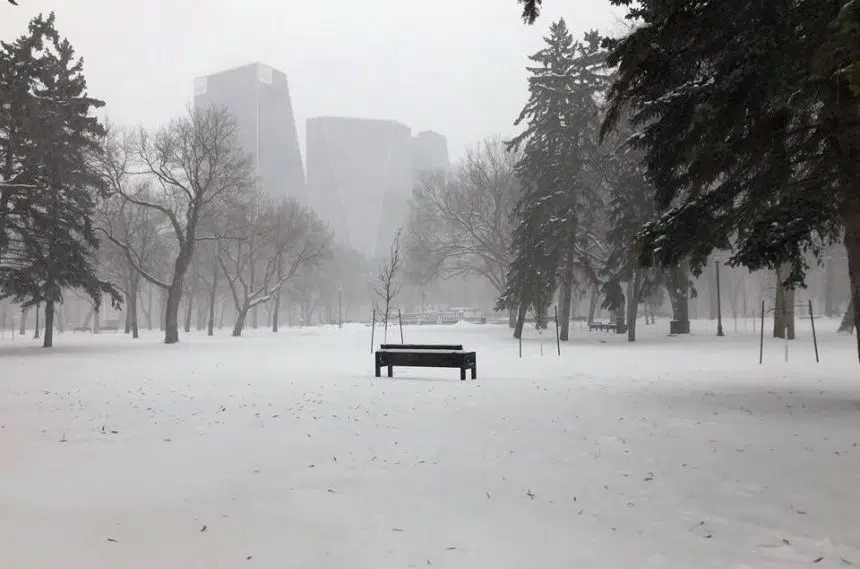People in Regina and Saskatoon have been in a fog of late while they miss sunny days.
Environment Canada meteorologist Terri Lang says the last time Saskatchewan’s two major cities saw the sun for an extended period of time was Jan. 7.
While that has led to milder temperatures, it has allowed for extended periods of fog and mist to blanket Regina and Saskatoon as well as parts of the surrounding area.
To show just how bad the fog has been, Environment Canada says a typical January in Saskatoon would see 6.57 hours of fog accumulated throughout the month. Already this year, that city has had 24 hours of fog.
Regina is seeing a similar trend. It typically gets 4.6 hours of fog in January, but has already had 11 hours.
That could be a little generous too, considering Environment Canada only defines fog as occurring when visibility on the road is under a kilometre.
Lang explained why this is happening.
“It’s been a lack of weather systems that we’ve been having,” she said. “Normally (when) weather systems come through, we have a lot of wind, it blows through, we get some colder air (and) we get some sunshine. But all of the weather systems have either been going to the far Arctic in the north or far to the south towards California.
“We’re kind of just sitting in this ‘dead zone’ in the middle where no weather systems have been going through. What happens is we kind of get into a stagnant weather pattern and what’s being formed is an inversion.”
That inversion is causing the air to get capped. That’s leading to warmer weather and the fog we’re seeing.
Because there was no wind or weather systems passing through over the past week, it’s just allowing the system to hang around.
The inversion is also leading to lots of rime ice on trees and power lines. While it looks like hoar frost, it’s actually very harmful.
“With that moisture, we’re getting the fog forming and with the fog forming, we’re getting freezing drizzle. Because of these liquid particles floating around, they can exist to a temperature of -25 Celsius before they freeze,” Lang said. “As soon as it encounters anything like trees, cars, buildings or power lines, it freezes instantly.”
While the weather has put a damper on spirits for some, others in Regina were taking advantage of it Thursday.
“I am loving the frost. It’s beautiful!” Margie McDonald said as she was out for a skate at the Victoria Park rink.
Tatha Banerjee was out for his lunch break by Scarth Street and felt the same way.
“Personally, it’s January and the weather is -6 to -10, so it’s much better than -40. But it would be real nice if we could have a little sunshine,” he explained.
“Foggy is sometimes depressing, but it’s better than -40.”
Banerjee said he has been getting out more often with his family because the weather has been nice.
Imran Ghori was also out on his lunch break and is eager to see some clear days.
“I’m actually missing the sun and wishing and hoping it comes back again. (The fog) is not something that’s usually here in Regina (in the winter), but we have to live with it,” Ghori said.
He doesn’t think he’s ever seen it this grey.
“In the winter, you need to see the sun, even if it’s (for) a brief period. This feels a little bit gloomy,” said Ghori, who noted he’d rather take the sun and cold weather over the warmth and grey skies.
But he did say he’s getting out more because the weather has been better.
“I never used to go out and take my lunch,” he said. “I’d just eat my lunch and stay in there. Now I go (for) a little bit more walking.”
Environment Canada has some good news for Ghori: The weather is going to start improving over the weekend.
Lang said a Mackenzie low is going to start heading towards Regina and Saskatoon, which will bring some wind, potential freezing rain, snow and even some sun over the weekend.
“We’re finally going to get rid of this low cloud and fog,” she said. “I think once we hit the weekend, we won’t see much of this low cloud and fog and all the rime icing will be melted or blown off the trees.”
Over the weekend, Regina and Saskatoon are looking at highs between -2 C and -6 C.











